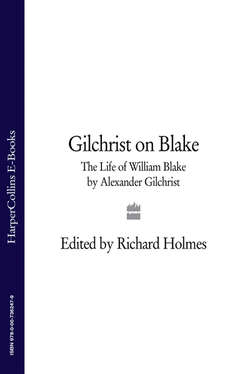Читать книгу Gilchrist on Blake: The Life of William Blake by Alexander Gilchrist - Richard Holmes - Страница 5
INTRODUCTION 1
ОглавлениеWhen William Blake died in London in 1827, he was already a forgotten man. He had been living in two-room lodgings in Fountain Court, in the Middle Temple, off Fleet Street. His engraved and hand-painted Songs of Innocence and of Experience, had sold less than twenty copies in thirty years. His Prophetic Books had disappeared almost without trace. A single mysterious poem – The Tyger’ – had reached the anthologies. As a poet – once read in manuscript by Coleridge, Wordsworth and Charles Lamb – he was virtually unknown outside a small circle of disciples, a group of young men who pointedly called themselves The Ancients’. Robert Southey, the Poet Laureate, magnanimously dismissed him ‘a man of great, but undoubtedly insane genius’.
As an artist, his reputation was little better. He was chiefly remembered as a one-time commercial engraver of grimly improving texts: Edward Young’s Night Thoughts, Robert Blair’s The Grave, the dark Biblical drama of the Book of Job, and Dante’s Inferno still unfinished at the time of his death. In 1830 Blake was given a short and gently patronizing entry in Alan Cunningham’s Lives of the Most Eminent British Painters. The illuminations to The Songs of Innocence, and the Book of Job, were mildly admired. The Tyger’ was re-printed as an example of fascinating eccentricity.
But Cunningham damned him with faint praise. Blake was a lovable, minor eccentric: unworldly, self-taught and self-deluded. He produced work that was ‘unmeaning, mystical and extravagant’. He was a man ‘overmastered’ by his own imagination. He confused ‘the spiritual for the corporeal vision’. But for the stabilizing influence of his faithful – but ‘illiterate’ – wife Kate, William Blake would be remembered simply as ‘a madman’.
Three years later, in March 1833, the Monthly Magazine wittily celebrated Blake’s lunacies. ‘Blake was an embodied sublimity. He held converse with Michael Angelo, yea with Moses; not in dreams, but in the placid still hour of the night – alone, awake – with such powers as he possessed in their full vigour…He chatted with Cleopatra, and the Black Prince sat to him for a portrait. He reveled in the past; the gates of the spiritual world were unbarred at his behest, and the great ones of bygone ages, clothed in the flesh they wore on earth, visited his studio.’
Blake was diagnosed as a sufferer of extreme and persistent visual hallucinations, a man who ‘painted from spectres’, and had lost his grasp on reality. ‘His may be deemed the most extraordinary case of spectral illusion that has hitherto occurred. Is it possible that neither Sir Walter Scott, nor Sir David Brewster – the authors of Demonology and Witchcraft and Natural Magic – ever heard of Blake?’
This article had great success, and was copied by the smart Parisian magazine, La Revue Britannique, the following year. The translation was a little hurried, and opened with the assertion that not only was the ‘spectral’ William Blake still alive, but he was actually incarcerated in a London madhouse. The two most celebrated inmates of the madhouse of Bedlam in London are the arsonist Martin, estranged elder brother of the painter John Martin, and William Blake – nicknamed “The Seer”.’
Twenty years after his death, ‘mad’ Blake’s reputation was barely taken seriously at all. A large manuscript collection of his work was offered for private sale by a keeper at the British Museum in 1847. It consisted of a foolscap quarto sketchbook of 58 leaves, packed with Blake’s unpublished poems and drawings. It would now be considered priceless, but then it was sold for a mere ten shillings and sixpence.
The purchaser was Dante Gabriel Rossetti. Vague plans to publish it by the Pre-Raphaelite brotherhood were mooted, and Dante’s brother the critic William Rossetti, expressed an interest. But on examination it was put quietly aside as too difficult and obscure to interest the public. A whole generation had now elapsed, the surviving ‘Ancients’ were indeed growing old, and the memory of ‘mad’ Blake was dwindling to nothing. It is possible that the author of The Tyger’ might have been entirely lost.
Then, thirteen years later, on 1 November 1860, Rossetti wrote to his friend the poet William Allingham with surprising news. ‘A man (one Gilchrist, who lives next door to Carlyle) wrote to me the other day, saying he was writing a Life of Blake, and wanted to see my manuscript by that genius. Was there not some talk of your doing something by way of publishing its contents? I know William thought of doing so, but fancy it might wait long for his efforts…I have not engaged myself in any way to the said Gilchrist on the subject, though I have told him he can see it here if he will give me a day’s notice.’
When the ‘said Gilchrist’ finally visited in March 1861, Rossetti was surprised to encounter a long-haired, dreamy, moon-faced young man who looked rather as if he had stepped out of one of his own Pre-Raphaelite paintings. Alexander Gilchrist was thirty-two, a young writer and art critic, who announced quietly that he had been working on a Life of Blake for the last six years. Indeed, he had already signed a contract with the publisher Macmillan. He did not think William Blake was mad; in fact he thought he was a genius. He was going to transform his reputation, however long it took him, and whatever it cost him.
